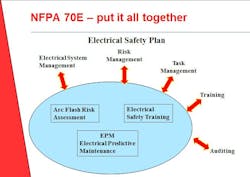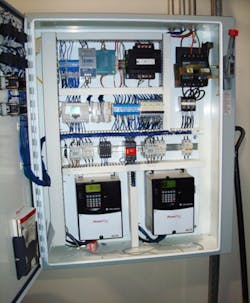Based on our experience of working with customers in the development of their electrical safety plans, our perspective on electrical safety plans has evolved over the years — from being a difficult compliance requirement to a strategic assessment tool that measures all aspects of existing practices and systems and their overall contributions to meeting the requirements outlined in NFPA 70E, Standard for Electrical Safety in the Workplace.
In the August 2021 issue, I discussed best practices for the successful implementation of an NFPA 70E program in “Essential Elements of an Arc Flash Risk Assessment.” Taking that concept a step further, this article will reveal why a structured outline is necessary to achieve the most effective electrical safety plan.
Success in writing such a plan is based upon using the following outline (see the Figure):
- Electrical system management
- Electrical safety training
- Risk management
- Task management
- Safety program auditing
The development of an electrical safety plan includes mapping the 70E Articles into this functional outline. This mapping creates a full set of 70E topics that are included in each section of the plan. In other words, the electrical safety plan begins with the 70E-based framework from which existing practices and systems are evaluated/measured for compliance. Let’s take a closer look at a few of these areas.
Safety training
In the “electrical safety training” segment of the plan, the 70E directives for training record-keeping result in a full requirements specification. The mapping of the 70E standard created the compliance requirements that training documentation shall include course content and training dates for each employee. Training records shall also be kept for each employee through the duration of their employment [Sec. 110.6]. Training records begin with course content. Each course that is tracked has its own profile that can include the course outline, copies of hand outs/course materials, the course owner, and possibly provider information, course costs, and other attributes.
An events log tracks each training event that references a course, the date, and the listing of employees that participated in the training event on that date. Using this approach, multiple training events will reference a single course if that course is presented with frequency.
The last segment of training records is the individual employee’s record. Here, a log of training events attended by the employee and a place to store training certificates are specified.
Training records organized within this structure will easily support the auditing requirements for identifying when retraining shall occur. Additionally, the employee’s training log can be included in employee professional development reviews.
One additional structure derived from the electrical safety plan framework focuses on the development of the qualified individual. 70E states that training records shall include when a qualified individual achieves a demonstrated proficiency in work practices. These work practices can include energized safe work practices outlined in the 70E standard, such as completing a job safety plan, boundaries, PPE selection, and work practices specific to the limited and restricted approach boundaries. Demonstrated proficiency also included the skills and work practices acquired by on-the-job and ongoing mentoring/training.
Task management
The tasking section of the electrical safety plan includes development of the operating and troubleshooting procedures specific to the production equipment and devices at that facility. For each tasking procedure, the qualified individual can then be rated with assessments from no training/exposure to being able to train and mentor others.
These two conventions were developed as an outcome of the functional outline of the electrical safety plan. They are examples of the assessment structure to measure existing systems and procedures and identify missing elements of compliance.
The task management segment in this electrical safety plan is the most difficult to develop. One of the first recommendations is to develop equipment groups, where the troubleshooting procedures and complexity of the equipment are similar. Additionally, a fully implemented job safety plan program will be a documentation resource to determine the frequency of instances of energized work events. A safe work practices document, including full pictures of the equipment enclosures, wiring diagrams, and other supporting documentation, would be included in the tasking profile of that device (or device group).
This task management segment of the plan will handle the management of evaluating qualified individuals and their demonstrated proficiency for tasks defined throughout the facility. For a sample log of how all of this information is organized and documented, see Table 1 and Table 2.
To demonstrate how the electrical safety plan can be used as a working strategic tool, let’s look at one company’s installation of a new production line as an example.
Case study
One of our customers installed a new “cutting line.” During production (normal operations), this equipment produced very high internal voltages (greater than 10,000V) and has stored capacitor energy. The equipment requires special tasking to achieve an electrically safe work condition. Installation of this new line would require the following reviews and actions.
Electrical system management
- Inspection upon installation and startup. [Sec. 110.5(B)]
- Incorporate the new line into the electrical maintenance program. [Sec. 110.5(C)]
- Add the new line to the one-line diagram. [Sec. 205.2]
- Post new arc flash warning labels. [Sec. 130.5(H)]
Electrical safety training
- New technology, new types of equipment, or changes in procedures necessitate the use of safety-related work practices that are different from those the employee would normally use (Photo 1). [Sec. 110.6(3)]
- Consider additional warning labels like “high voltages” and “stored energy.”
Task management
- Write a new set of procedures and train employees to transition this equipment from normal operations to an electrically safe work condition.
Final thoughts
The unique framework of the structured outline discussed in this article creates a strong foundation for development of the electrical safety plan. The structured outline gives the project team a working table of contents for each section of the plan that assures coverage of the 70E standards. The baseline provided by this outline is not found in the example electrical safety plan of Annex E.
Overall, a more positive approach and a strong written plan were put in place when the project team worked with the electrical safety plan as a strategic assessment tool instead of a difficult-to-document compliance requirement. As each electrical safety plan project moved from start-up to completion, the project team gained a deeper understanding of the 70E standards and adopted the mindset of strategic assessment of existing work practices, systems, and procedures. Once the electrical safety plan is in place, the next evolution is systematic and ongoing management. The electrical safety plan’s audit section should contain the dates and tasking of ongoing safety plan management.
Chuck Fox is the general manager of The Electrician Inc.’s Specialty practice division, providing electrical testing and NFPA 70E compliance services. He has held the NFPA Certified Electrical Safety Compliance Professional (CESCP) certification since 2014. He can be reached at ChuckF@TheElectricianInc.








